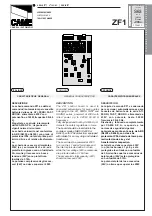
p6
2. CONFIGURATION OF THE NETWORK
First start by launching the configuration software SlimSet.
The purpose is to define your network using the software.
1) Connect a USB cable on the first instrument of the bus (the most on the left
or the most on the right).
Click on «communication with the devices» and then on «add the connected
device to the architecture».
The instrument will be recognized, and the software will request its position
within the architecture. Enter it, and do the same for all the instruments of the
bus.
2) Then choose the instrument which will be the master (TPIs or TPIvM) and
programme it as master if it is a TPIs (the orange led becomes active).
Important:
From the version 2.02 of the TPIs it is possible to access the configuration of
the instruments of the bus directly from the master..
In this case first connect the instrument defined as master (TPIs or TPIvM),
programme it as master if it is a TPIs and click on «communication through the
master» and then «add or remove some devices».
The software will then take up all the instruments present on the bus and read
their configuration one by one.
For each instrument detected, the SlimSet will request its position on the archi-
tecture. This position can be determined by a specific blinking of the green led
of the concerned instrument (morse code blinking: twice on, once off).
3) Then programme each of the instruments, as well as the links between ins-
truments:
for each of the outputs of the output modules (TPIs 4R, TPIs 2A/4A ...) you
must define the converter associated with this output, as well as the measure
associated with this output.
Measure
number
Type of the
instrument
TPIs 4T TPIs 6T
200
X
X
Status logic input n°1
201
X
X
Status logic input n°2
202
X
X
Status logic input n°3
203
X
X
Status logic input n°4
204
X
Status logic input n°5
205
X
Status logic input n°6
208
X
X
Register X result
209
X
X
Register Y result
210
X
X
Register Z result
4) Then transfer the programming of all the instruments of the bus.
Important:
From the version 2.02 of the TPIs, it is possible to transfer the programming
of the TPIs directly from the master.
For this purpose, connect yourself on the master and click on «communica-
tion with the devices» and then «communication through the master» and
then «send the configuration of all devices».
Then transfer the programming of the master.
5) Then validate the bus. For this purpose connect yourself on the master,
click on «validate network».
This will record the configuration of the bus in order to point out any error
(loss of a module for example).
The network must always be validated after adding / removing an instrument
and after the modification of all the links between instruments.




























